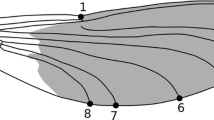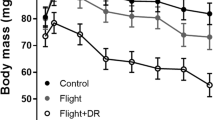Abstract
In many species, the ability to evade predators is known to be periodically impaired by increased weight loads due to feeding and reproduction. Not only may extra weight reduce escape speed, but feeding and mating can also make the prey more noticeable to visually hunting predators. A number of butterfly species mate for hours, and if a mating couple is disturbed, one of the butterflies is responsible for flying, whereas its partner remains still. This study investigated the ability of male Pieris napi butterflies to fly while mating, with the prediction that mate carrying impairs flight ability compared to single flying males and that males with relatively high flight muscle ratios (FMR; male thorax mass/male + female body mass) will have better flight performance in copula. Our results clearly show that whereas single males always take off at steep angles and fly upwards, couples invariably have a negative take-off angle and rarely gain height. Moreover, landing height of the couples is positively associated with higher FMR. Hence, male flight ability when in copula is positively associated with a high relative thorax mass. Butterfly pairs may thus be at greater risk of predation as a consequence of their impaired flight ability, especially couples with critically low FMRs (<16%).





Similar content being viewed by others
References
Almbro M, Kullberg C (2008) Impaired escape flight ability in butterflies due to low flight muscle ratio prior to hibernation. J Exp Biol 211:24–28
Bergström J, Wicklund C, Kaitala A (2002) Natural variation in female mating frequency in a polyandrous butterfly: effects of size and age. Anim Behav 64:49–54
Berwaerts K, Van Dyck H (2004) Take-off performance under optimal and suboptimal thermal conditions in the butterfly Pararge aegeria. Oecologia 141:536–545
Berwaerts K, Van Dyck H, Aerts P (2002) Does flight morphology relate to flight performance? An experimental test with the butterfly Pararge aegeria. Func Ecol 16:484–491
Bishop JA, Armbruster WS (1999) Thermoregulatory abilities of Alaskan bees: effects of size, phylogeny and ecology. Funct Ecol 13:711–724
Darwin C (1859) On the origin of species by means of natural selection, 1st edn. John Murray, London
Dudley R (2000) The biomechanics of insect flight: form, function, evolution. Princeton University Press, Princeton
Fairbairn DJ (1993) Costs of loading associated with mate-carrying in the waterstrider, Aquarius remigis. Behav Ecol 4:224–231
García-Barros E (2000) Body size, egg size, and their interspecific relationships with ecological and life-history traits in butterflies (Lepidoptera: Papilionidea, Hesperioidea). Biol J Linn Soc 70:251–284
Gwynne DT (1987) Sex-biased predation and the risky mate-locating behaviour of the male tick-tick cicadas (Homoptera: Cicadidae). Anim Behav 35:734–738
Hedenström A, Rosén M (2001) Predator versus prey: on aerial hunting and escape strategies in birds. Behav Ecol 12:150–156
Henriksen HJ, Kreutzer I (1982) The butterflies of Scandinavia in nature. Skandinavisk bogforlag A/S, Odense
Howard RD (1978) The evolution of mating strategies in bullfrogs, Rana catesbeiana. Evolution 32:850–871
Hughes L, Siew-Woon Chang B, Wagner D, Pierce NE (2000) Effects of mating history on ejaculate size, fecundity, longevity and copulation duration in the ant-tended lycaenid butterfly, Jalmenus evagoras. Behav Ecol Sociobiol 47:119–128
James RS, Johnston IA (1998) Influence of spawning on swimming performance and muscle contractile properties in the short-horn sculpin. J Fish Biol 53:485–501
Kingsolver JG, Srygley RB (2000) Experimental analyses of body size, flight and survival in pierid butterflies. Evol Ecol Res 2:593–612
Knopp MCN, Krenn HW (2003) Efficiency of fruit juice feeding in Morpho peleides (Nymphalidae, Lepidoptera). J Insect Behav 16:67–77
Kullberg C, Houston DC, Metcalfe NB (2002a) Impaired flight ability—a cost of reproduction in female blue tits. Behav Ecol 13:575–579
Kullberg C, Metcalfe NB, Houston DC (2002b) Impaired flight ability during incubation in the pied flycatcher. J Avian Biol 33:179–183
Lee SJ, Witter MS, Cuthill IC, Goldsmith AR (1996) Reduction in escape performance as a cost of reproduction in gravid starlings, Sturnus vulgaris. Proc R Soc Lond B 263:619–624
Lima SL, Dill LM (1990) Behavioural decisions made under the risk of predation: a review and prospectus. Anim Behav 68:619–640
Lindfors VS (1998) Butterfly life history and mating systems. PhD thesis, Stockholm University
Marden JH (1987) Maximum lift production during takeoff in flying animals. J Exp Biol 130:235–258
Marden JH (1989) Effects of load-lifting constraints on the mating system of a dance fly. Ecology 70:496–502
Marden JH, Chai P (1991) Aerial predation and butterfly design: how palatability, mimicry, and the need for evasive flight constrain mass allocation. Am Nat 138:15–36
McCauley DE, Lawson EC (1986) Mating reduces predation on male milkweed beetles. Am Nat 127:112–117
Miles DB, Sinervo B, Frankino WA (2000) Reproductive burden, locomotor performance, and the cost of reproduction in free ranging lizards. Evolution 54:1386–1395
Morse DH (1975) Ecological aspects of adaptive radiation in birds. Biol Rev 50:167–214
Otronen M (1997) Mating behaviour and sexual size dimorphism in Scathophaga inquinata. Ann Zool Fenn 34:241–246
Pivnick KA, McNeil JN (1986) Sexual differences in the thermoregulation of Thymelicus lineola (Lepidoptera: Hesperiide). Ecology 67:1024–1035
Pullin AS (1987) Adult feeding time, lipid accumulation, and overwintering in Aglais urticae and Inachis io (Leptidoptera: Nymphalidae). J Zool Lond 211:631–641
Roitberg BD, Mondor EB, Tyerman JGA (2003) Pouncing spider, flying mosquito: blood acquisition increases predation risk in mosquitoes. Behav Ecol 14:736–740
Ryan MJ (1985) The Tungara frog: a study in sexual selection and communication. University of Chicago Press, Chicago
Schwartzkopf L, Shine R (1992) Costs of reproduction in lizards: escape tactics and susceptibility to predation. Behav Ecol Sociobiol 31:17–25
Seigel RA, Huggins MM, Ford NB (1987) Reduction in locomotor ability as a cost of reproduction in gravid snakes. Oecologia 73:481–485
Shaffer LR, Formanowicz DR Jr (1996) A cost of viviparity and parental care in scorpions: reduced sprint speed and behavioural compensation. Anim Behav 51:1017–1024
Sih A, Krupa J, Travers S (1990) An experimental study on the effects of predation risk and feeding regime on the mating behavior of the water strider. Am Nat 135:284–290
Sivinski J (1980) The effects of mating on predation in the stick insect Diapheromera veliei Walsh (Phasmatodea: Heteronenemiidae). Ann Entomol Soc Am 73:553–556
Spangler HG (1988) Moth hearing, defense, and communication. Ann Rev Entomol 33:59–81
Srygley R (1994) Locomotor mimicry in butterflies? The associations of positions of centres of body mass among broups of mimetic, unprofitable prey. Philos Trans R Soc Lond B Biol Sci 343:145–155
Srygley RB, Chai P (1990) Flight morphology of Neotropical butterflies: palatability and distribution of mass to the thorax and abdomen. Oecologia 84:491–499
Srygley RB, Dudley R (1993) Correlations of the position of centre of body mass with butterfly escape tactics. J Exp Biol 174:155–166
Srygley RB, Kingsolver JG (2000) Effects of weight loading on flight performance and survival of palatable Neotropical Anartia fatima butterflies. Biol J Linn Soc 70:707–725
Svärd L, Wiklund C (1986) Different ejaculate delivery strategies in first versus subsequent matings in the swallowtail butterfly Papilio machaon. Behav Ecol Sociobiol 18:325–330
Thornhill R, Alcock J (1983) The evolution of insect mating systems. Harvard University Press, Cambridge, MA
Tsuji JS, Kingsolver JG, Watt WB (1986) Thermal physiological ecology of Colias butterflies in flight. Oecologia 69:161–170
Verrell PA (1985) Predation and the evolution of precopula in the isopod Asellus aquaticus. Behaviour 95:198–202
Ward PI (1986) A comparative field study of the breeding behaviour of a stream and a pond population of Gammarus pulex (Amphipoda). Oikos 46:29–36
Wiklund C (2003) Sexual selection and the evolution of butterfly mating systems. In: Boggs CL, Watt WB, Ehrlich PR (eds) Butterflies: ecology and evolution taking flight. Chicago University Press, Chicago, pp 67–90
Wiklund C, Forsberg J (1985) Courtship and male discrimination between virgin and mated females in the orange tip butterfly, Anthocharis cardamines. Anim Behav 34:328–332
Wiklund C, Forsberg J (1991) Sexual size dimorphism in relation to female polygamy and protandry in butterflies: a comparative study of Swedish Pieridae and Satyridae. Oikos 60:373–381
Wiklund C, Kaitala A (1995) Sexual selection for large male size in a polyandrous butterfly: the effect of body size on male versus female reproductive success in Pieris napi. Behav Ecol 6:6–13
Wiklund C, Karlsson B (1988) Sexual size dimorphism and fecundity in satyrid butterflies: a reply to Harvey’s comment. Am Nat 136:268–269
Wiklund C, Lindfors V, Forsberg J (1996) Early male emergence and reproductive phenology of the adult overwintering butterfly Gonopteryx rhamni in Sweden. Oikos 75:227–240
Acknowledgments
We would like to thank C. Wiklund, B. Borg, H. Løvlie, J. Fitzpatrick, and R. Dean for comments on the paper. We are also grateful for comments and suggestions from two anonymous reviewers. The experiment complies with the current laws of the country in which they were performed. Financial support was received from the Swedish Research Council (to C.K).
Author information
Authors and Affiliations
Corresponding author
Additional information
Communicated by N. Wedell
Rights and permissions
About this article
Cite this article
Almbro, M., Kullberg, C. The downfall of mating: the effect of mate-carrying and flight muscle ratio on the escape ability of a pierid butterfly. Behav Ecol Sociobiol 63, 413–420 (2009). https://doi.org/10.1007/s00265-008-0675-4
Received:
Revised:
Accepted:
Published:
Issue Date:
DOI: https://doi.org/10.1007/s00265-008-0675-4




